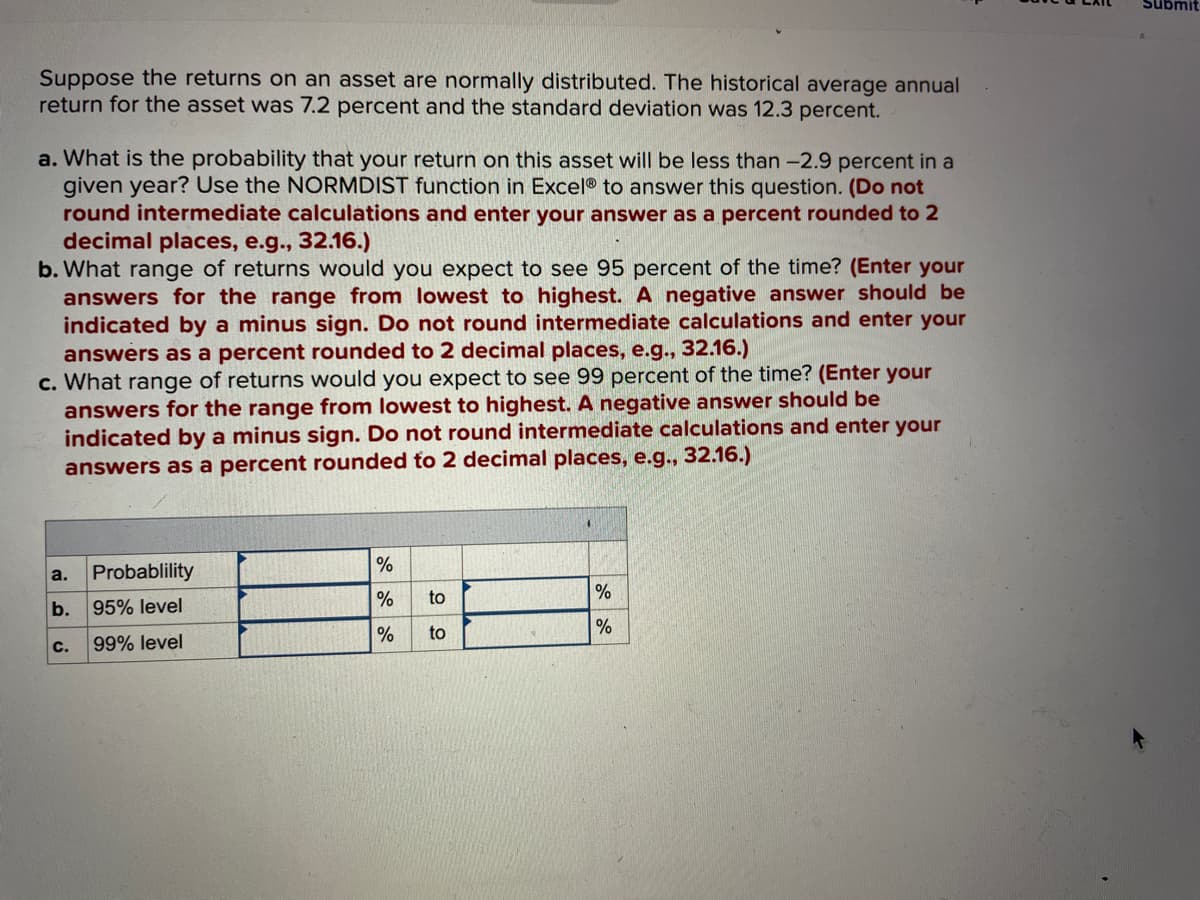Suppose the returns on an asset are normally distributed. The historical average annual return for the asset was 7.2 percent and the standard deviation was 12.3 percent. a. What is the probability that your return on this asset will be less than -2.9 percent in a given year? Use the NORMDIST function in Excel® to answer this question. (Do not round intermediate calculations and enter your answer as a percent rounded to 2 decimal places, e.g., 32.16.) b. What range of returns would you expect to see 95 percent of the time? (Enter your answers for the range from lowest to highest. A negative answer should be indicated by a minus sign. Do not round intermediate calculations and enter your answers as a percent rounded to 2 decimal places, e.g., 32.16.) c. What range of returns would you expect to see 99 percent of the time? (Enter your answers for the range from lowest to highest. A negative answer should be indicated by a minus sign. Do not round intermediate calculations and enter your answers as a percent rounded to 2 decimal places, e.g., 32.16.)
Suppose the returns on an asset are normally distributed. The historical average annual return for the asset was 7.2 percent and the standard deviation was 12.3 percent. a. What is the probability that your return on this asset will be less than -2.9 percent in a given year? Use the NORMDIST function in Excel® to answer this question. (Do not round intermediate calculations and enter your answer as a percent rounded to 2 decimal places, e.g., 32.16.) b. What range of returns would you expect to see 95 percent of the time? (Enter your answers for the range from lowest to highest. A negative answer should be indicated by a minus sign. Do not round intermediate calculations and enter your answers as a percent rounded to 2 decimal places, e.g., 32.16.) c. What range of returns would you expect to see 99 percent of the time? (Enter your answers for the range from lowest to highest. A negative answer should be indicated by a minus sign. Do not round intermediate calculations and enter your answers as a percent rounded to 2 decimal places, e.g., 32.16.)
Glencoe Algebra 1, Student Edition, 9780079039897, 0079039898, 2018
18th Edition
ISBN:9780079039897
Author:Carter
Publisher:Carter
Chapter10: Statistics
Section10.6: Summarizing Categorical Data
Problem 31PPS
Related questions
Question

Transcribed Image Text:Suppose the returns on an asset are normally distributed. The historical average annual
return for the asset was 7.2 percent and the standard deviation was 12.3 percent.
a. What is the probability that your return on this asset will be less than -2.9 percent in a
given year? Use the NORMDIST function in Excel® to answer this question. (Do not
round intermediate calculations and enter your answer as a percent rounded to 2
decimal places, e.g., 32.16.)
b. What range of returns would you expect to see 95 percent of the time? (Enter your
answers for the range from lowest to highest. A negative answer should be
indicated by a minus sign. Do not round intermediate calculations and enter your
answers as a percent rounded to 2 decimal places, e.g., 32.16.)
c. What range of returns would you expect to see 99 percent of the time? (Enter your
answers for the range from lowest to highest. A negative answer should be
indicated by a minus sign. Do not round intermediate calculations and enter your
answers as a percent rounded to 2 decimal places, e.g., 32.16.)
a.
b.
C.
Probablility
95% level
99% level
%
%
to
% to
%
%
Submit
Expert Solution
This question has been solved!
Explore an expertly crafted, step-by-step solution for a thorough understanding of key concepts.
This is a popular solution!
Trending now
This is a popular solution!
Step by step
Solved in 4 steps with 1 images

Recommended textbooks for you

Glencoe Algebra 1, Student Edition, 9780079039897…
Algebra
ISBN:
9780079039897
Author:
Carter
Publisher:
McGraw Hill

Glencoe Algebra 1, Student Edition, 9780079039897…
Algebra
ISBN:
9780079039897
Author:
Carter
Publisher:
McGraw Hill